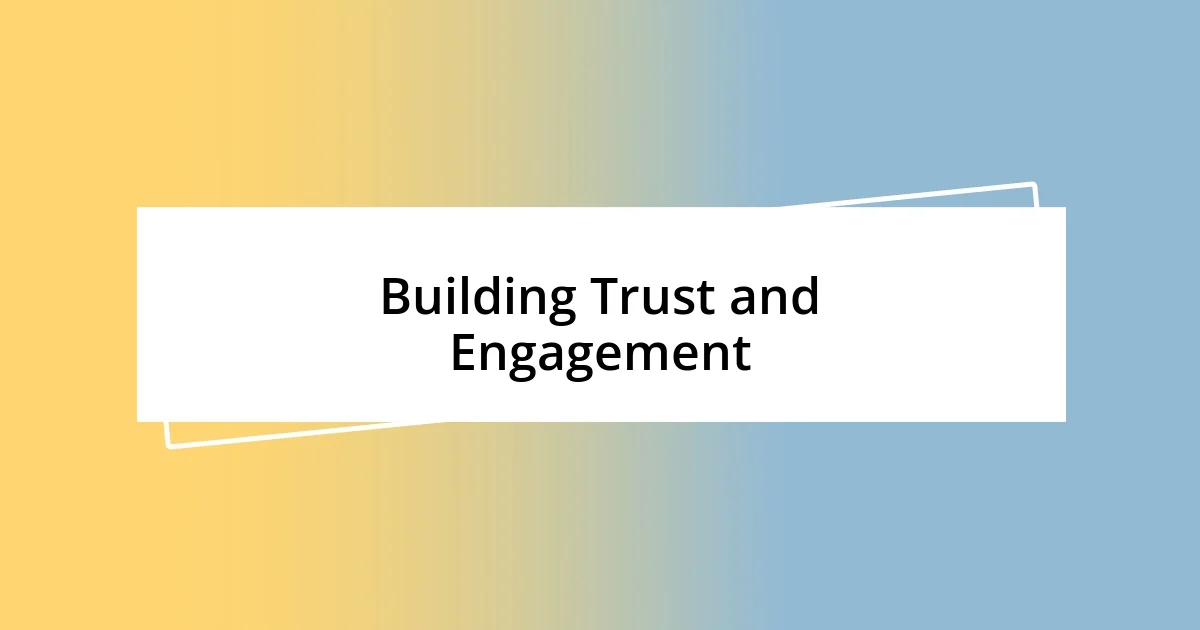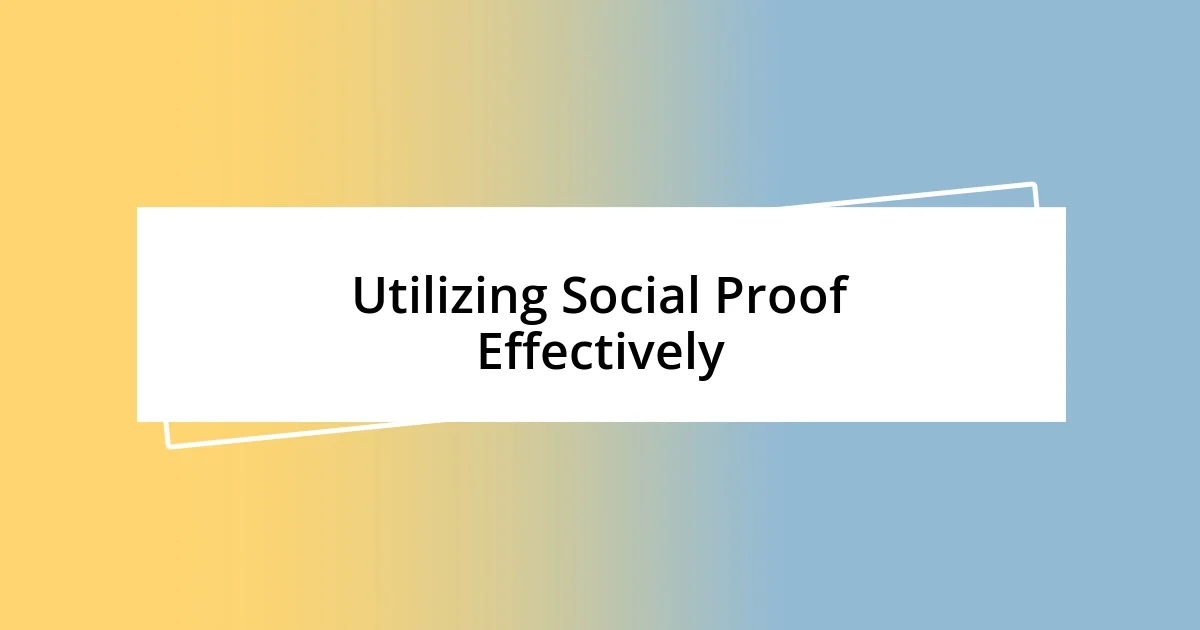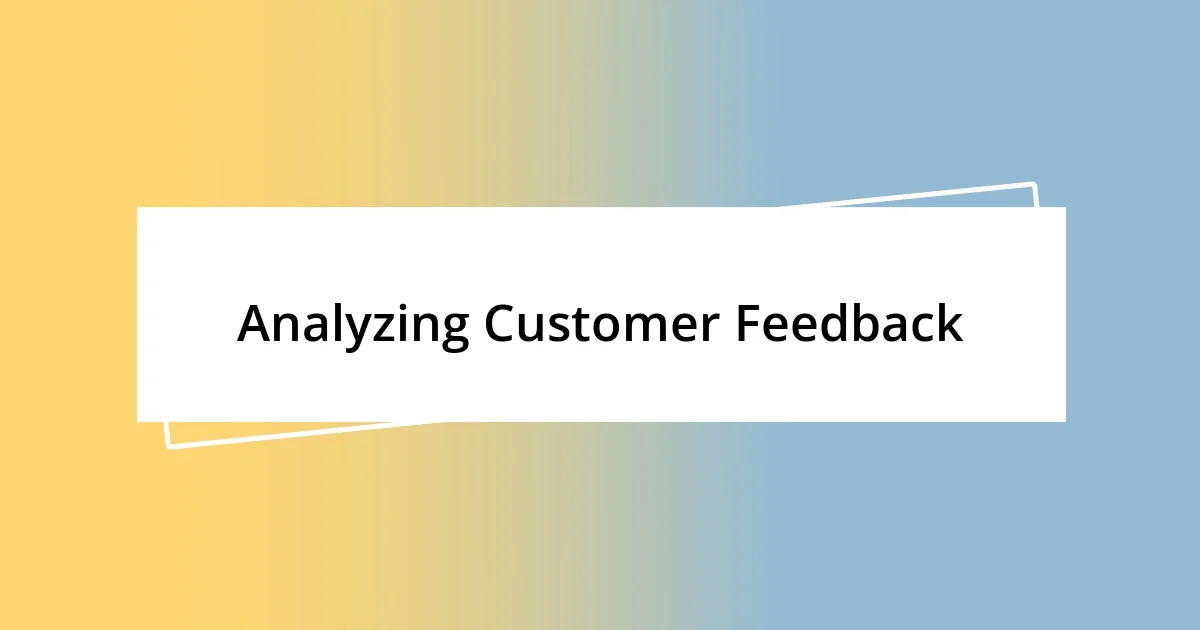Key takeaways:
- Understanding your audience through direct communication fosters loyalty and transforms followers into engaged customers.
- Building trust via personal stories, transparency, and user-generated content enhances engagement and community connection.
- Measuring success through analytics, audience feedback, and emotional responses helps refine strategies and deepen customer relationships.

Understanding Your Audience
Understanding your audience is paramount. I remember the first time I launched a new product without really knowing who my followers were. It led to a disappointing turnout, and I realized that connecting with them on a personal level makes all the difference. Have you ever felt like you were shouting into the void? It’s because the message just isn’t resonating with the right people.
Diving deeper into audience preferences can reveal powerful insights. I’ve often asked my followers directly about their needs and interests through polls and surveys. The responses were eye-opening! It’s really about creating a dialogue and showing that you genuinely care about what they think. This two-way communication fosters loyalty and transforms passive followers into engaged customers.
When you understand your audience, you can tailor your content to truly reflect their desires. For instance, I once tailored a social media campaign based on feedback I received regarding preferred product features. The increase in engagement was incredible! It felt as though I was finally speaking their language, and that shared understanding brought more customers into the fold. Isn’t it rewarding to know your words carry meaning for someone else?

Building Trust and Engagement
Building trust is essential if you want your followers to transition into loyal customers. I once hosted a live Q&A session to address the common questions I received about my products. At first, I was nervous about showing my face and opening up, but the connection that came from that candid interaction was profound. Seeing their reactions in real-time as I shared my experiences made me realize that vulnerability fuels trust.
To enhance trust and engagement, consider these strategies:
- Share personal stories and experiences related to your products.
- Be transparent about your processes, including successes and setbacks.
- Actively respond to comments and messages to foster a sense of connection.
- Create polls or surveys that invite feedback on your offerings.
- Celebrate user-generated content to showcase genuine customer experiences.
When I adopted these methods, I noticed not only a spike in interactions but also deeper conversations with my audience. It felt fulfilling to witness people trust me enough to share their own experiences too. That level of engagement is what truly cultivates a community.

Creating Compelling Content Strategies
Creating content that resonates with your audience is key to transforming followers into customers. When I began developing my content strategy, I focused on storytelling that reflects my brand. I remember crafting a post about my entrepreneurial journey, warts and all. The response was overwhelming, with people sharing their own challenges and aspirations. It was amazing to see how vulnerability opened a door to connection and dialogue, inviting followers to engage more deeply with my brand.
Engaging visuals also play a crucial role in a compelling content strategy. For instance, I invested time in creating eye-catching infographics that highlighted customer success stories. One particular visual created for a campaign about product uses not only showcased the versatility but also encouraged followers to share their experiences. Have you ever watched people share your content? It’s thrilling! Seeing my followers transform into advocates taught me that appealing visuals can ignite conversation, making my message more memorable.
Consistency is another factor that cannot be overlooked. Establishing a content calendar helped me maintain a regular posting schedule, which in turn nurtured anticipation among my audience. I found that maintaining a rhythm allowed me to experiment with various formats—like videos, blogs, and live sessions. With each post, I noticed a gradual increase in engagement, as loyal followers began to actively await my updates. Engaging with your audience on a consistent basis helps build momentum, pushing them closer to becoming customers.
| Key Elements | Strategies & Examples |
|---|---|
| Storytelling | Sharing personal journeys can humanize your brand. |
| Visual Content | Use infographics and engaging images to catch attention. |
| Consistency | Develop a content calendar to maintain regular engagement. |

Utilizing Social Proof Effectively
Utilizing social proof can significantly influence potential customers’ perceptions of your brand. A great example from my experience is when I shared customer testimonials on my social media platforms. The positive feedback highlighted real experiences and outcomes, and the engagement was incredible. It made me wonder—how often do you tap into the voices of your satisfied customers? Seeing others validate your product or service can create an instant connection and boost trust among your followers.
Moreover, user-generated content (UGC) became a game-changer for me. I initiated a monthly challenge encouraging my followers to share how they use my products, and the results blew my mind! It was heartwarming to receive photos and stories that showcased their creativity. This not only enriched my content but also fostered a sense of community. When potential customers see real people enjoying my offerings, they feel more inclined to jump on board, right? It’s a beautiful reminder that social proof isn’t just about numbers; it’s about real interactions and relationships.
Lastly, displaying social metrics, like the number of followers or shares, effectively demonstrates that others trust and enjoy your brand. I’ve experienced the power of a simple statistic—when I hit a milestone of a thousand followers, I created a post celebrating that moment. The influx of comments and shares reinforced the community’s belief in what I was doing. It raised the question for my audience: “If so many people believe in this, why shouldn’t I?” That’s what reminded me of the magnetic pull of social proof; it’s not just a number but a conversation starter that can lead to real business growth.

Effective Call to Action Techniques
Creating an effective call to action (CTA) is all about clarity and urgency. I remember when I first started crafting my CTAs; I often overcomplicated them. It was a lightbulb moment when I realized that a simple, direct statement like “Sign up now to get 20% off!” sparked more engagement. Think about it—can your followers clearly understand what you’re asking them to do? If not, they might just scroll past.
In my experience, using actionable language has made a huge difference. Phrases like “Discover your potential” or “Join our community today!” create a sense of excitement and involvement. When I integrated these kinds of CTAs into my posts, I noticed a notable boost in click-through rates. Have you ever felt a rush of excitement when pressing “subscribe” or “buy now”? That emotional drive can be harnessed in your CTAs to motivate your audience to take action.
Another technique that worked wonders for me was adding visuals to my CTAs. I experimented with designing bright, eye-catching buttons that drew the eye. One campaign featured a bold “Grab Your Free Trial” button, and I watched as interactions surged. Visuals not only grab attention but can guide the follower’s mindset towards feeling compelled to act. I often ask myself, “What can I create that’s not only informative but also visually irresistible?” Tailoring your CTAs this way can make them not just instructions but invitations to a rewarding experience.

Analyzing Customer Feedback
Analyzing customer feedback has been a pivotal part of my journey in turning followers into loyal customers. I remember digging through comments and messages, feeling a mix of excitement and apprehension. Catching glimpses of insights about what my audience truly wanted opened my eyes in ways I hadn’t anticipated. Have you ever been surprised by the feedback you received? I certainly was, and it helped me refine my offerings to truly resonate with my audience.
One particular instance sticks out in my mind. After launching a new product, I prompted my followers to share their thoughts on it. The outpouring of both praise and constructive criticism was illuminating. It felt like a conversation rather than a simple survey; the insights I gleaned led to modifications that ultimately improved the product. How often do we leave valuable conversations untapped? For me, that was an eye-opener—feedback isn’t just noise; it’s a treasure trove of opportunities waiting to be explored.
Taking action based on feedback transformed my approach to customer engagement. I realized that being responsive to what my customers said builds a stronger connection. When I integrated their suggestions, I made them feel valued, like they were part of the creative process. I often think about the power of listening—have you considered how much listening can boost loyalty? It’s a simple yet profound step; when customers see their voices echoing in your brand, they’re not just followers anymore; they become invested stakeholders in your success.

Measuring Success and Improvement
Measuring success and improvement is a continual journey that I love diving into. When I first started gauging my efforts, I leaned heavily on analytics—like tracking conversion rates and engagement metrics. It was fascinating to see how small tweaks to my content could lead to significant shifts in behavior. Have you ever experienced that moment when a minor adjustment results in remarkable growth? That’s the beauty of measurement; it gives you clarity on what works and what doesn’t.
In a memorable campaign, I used A/B testing to evaluate two different promotional strategies. One version resonated with a younger audience, while the other appealed to a more seasoned demographic. I discovered that understanding my audience’s preferences was key to tailoring my message. This experiment encouraged me to continuously ask, “Who am I really talking to?” By revisiting my target audience after every campaign, I could fine-tune my strategy for better outcomes.
Reflecting on results isn’t just about numbers; it’s also about the stories behind them. I often encourage myself to consider the emotional responses tied to metrics. For instance, if there’s a spike in user engagement, I ask why it happened—what struck a chord? Analyzing those moments of connection enriches my strategy, showing me the heart of my audience. Have you ever thought about how emotional intelligence plays a role in your business success? For me, it’s a powerful reminder that data can show patterns, but the true meaning comes from understanding the people behind the clicks.














